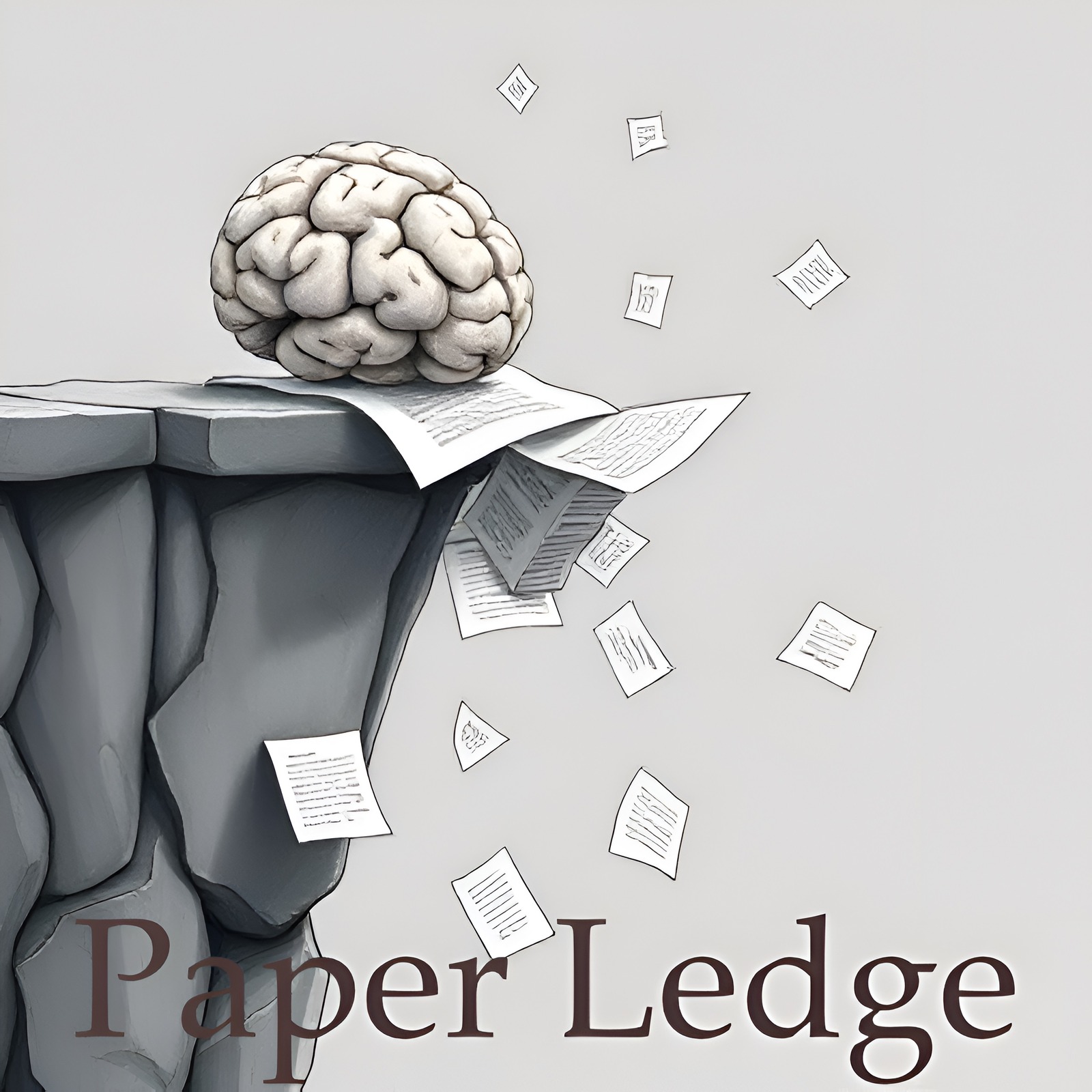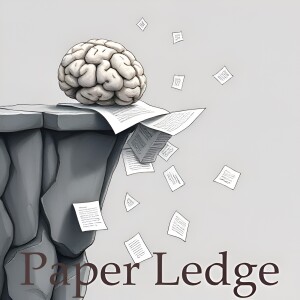PaperLedge

PaperLedge where research meets storytelling is a revolutionary podcast where cutting-edge research meets AI-powered storytelling. Hosted by the Ernis, whose blend of gentle reassurance, cosmic wonder, explanatory clarity, and enthusiastic charm makes complex research accessible to everyone. Each episode, Ernis transforms the latest academic papers into engaging, jargon-free audio experiences that deliver key insights in digestible formats. Whether you’re a researcher seeking interdisciplinary perspectives, a student supplementing your studies, or simply curious about scientific breakthroughs, PaperLedge has something for you.
Episodes
Episodes



Wednesday Oct 22, 2025
Computation and Language - How Do LLMs Use Their Depth?
Wednesday Oct 22, 2025
Wednesday Oct 22, 2025
Alright learning crew, Ernis here, ready to dive into some fascinating research that peeks inside the "brain" of those massive Large Language Models, or LLMs as we affectionately call them. You know, the ones powering chatbots and writing assistants all over the place.
This paper, in essence, is like giving us a backstage pass to see how these models think, layer by layer, when they're spitting out answers. And what they found is pretty darn interesting: it's not a uniform process. It's not like every layer is equally important for every single word they generate.
Think of it like this: Imagine you're trying to guess the punchline to a joke. At first, based on the setup, you might make a quick, statistical guess – the most common, predictable thing that usually follows. That's kinda what the early layers of the LLM are doing, throwing out some initial, often high-frequency, guesses. The researchers call this the "Guess-then-Refine" framework, and I think it's a great way to think about it.
But then, as you hear more of the joke, you refine your guess, incorporating the nuances and specific details. The later layers of the LLM do the same thing! They take those initial guesses and, using the growing contextual information, transform them into something that actually fits the situation. The cool part? Even if the initial guess was a common word, it still gets refined a HUGE percentage of the time – over 70%! So even seemingly "easy" words are being continuously processed and adjusted.
The researchers didn't stop there. They dug deeper, looking at different kinds of tasks. For example, they analyzed:
Part-of-Speech: Turns out, those little function words, like "the," "a," and "is," are often the first ones the model gets right. Almost like they form the scaffolding upon which the rest of the sentence is built.
Fact Recall: If you ask the model a factual question with a multi-word answer, the first word of the answer requires the most processing. It's like setting the stage for the rest of the response.
Multiple Choice: The model figures out the format of the answer (is it A, B, C, or D?) pretty early on, but it doesn't actually commit to a specific answer until later in the process. This really speaks to how the models use later layers to make those final decisions.
So, why does all this matter? Well, for one, it gives us a better understanding of these complex systems. But more practically, it could lead to more efficient models. If we know which layers are doing what, we can potentially optimize the model, maybe even skip certain layers for certain tasks, saving processing power and energy.
This research is relevant to:
AI Researchers: Obviously, this is gold for anyone working on improving LLMs.
Developers: Understanding how these models work can help developers build better applications.
Anyone using AI: Even if you're just using ChatGPT for fun, knowing a little bit about what's going on under the hood can help you understand its strengths and limitations.
Here's a thought: if LLMs "guess then refine," are we humans doing the same thing when we communicate? Are our initial thoughts just quick, statistically-likely guesses that we then polish as we gather more information?
Also, could this "Guess-then-Refine" framework explain why LLMs sometimes hallucinate? Perhaps those early guesses become so ingrained that the later layers struggle to correct them, even when the context contradicts them.
Finally, if different types of words or tasks rely on different layers, could we train specialized mini-models that only focus on certain aspects of language? Could we design an AI tool that is better at quickly selecting a word or concept?Credit to Paper authors: Akshat Gupta, Jay Yeung, Gopala Anumanchipalli, Anna Ivanova



Wednesday Oct 22, 2025
Wednesday Oct 22, 2025
Alright learning crew, Ernis here, ready to dive into something super cool! Today, we're tackling a paper that's trying to give AI a much better sense of sight – like, really good sight. Think of it like this: you can glance at a picture and get the gist, but a detective needs to zoom in on the tiny details, right?
That's where this research comes in. It focuses on something called Multimodal Large Language Models, or MLLMs. Basically, these are AIs that can understand both images and text together. They're pretty amazing, but the paper points out that they sometimes struggle when things get complicated – like a really busy photo with tons of objects and how they all relate to each other.
Imagine trying to describe a crowded street scene. An MLLM might say "people, cars, buildings," but it could miss the kid chasing a runaway balloon, or the dog trying to steal a hotdog from a vendor. These are the important details and relationships that give the scene its meaning.
So, the researchers have been working on "region-level MLLMs," which is like giving the AI a magnifying glass. Instead of just looking at the whole picture, it can focus on specific areas. But here's the problem: previous attempts at this were like looking at each zoomed-in area in isolation. They missed the bigger picture! It's like focusing on the hotdog and the dog, but not realizing they're about to cause a massive pedestrian pile-up.
That's where Grasp Any Region (GAR) comes in! This is the researchers' new approach, and it's designed to give AI a really comprehensive understanding of images at the region level. They've got a clever trick called "RoI-aligned feature replay" (don't worry too much about the jargon!). The key is that GAR helps the AI use the overall context of the image to understand each zoomed-in region better. It's like having the detective look at the whole crime scene before focusing on the fingerprints.
GAR allows the AI to:
See Precisely: By understanding the whole scene, the AI can make more accurate observations about specific areas.
Connect the Dots: It can model how different regions interact, like understanding that the dog is because of the hotdog.
Reason Deeply: This leads to advanced reasoning, so the AI can answer complex questions about the image. Instead of just describing things, it can have a conversation!
Think of it like this: imagine showing GAR a picture of a kitchen. Instead of just saying "stove, refrigerator, sink," it could answer questions like, "Is the stove on?" or "What's the person cooking?" or "Are they likely to burn the food based on how high the flame is?" It's a huge step towards true image understanding.
Now, to test if GAR actually works, the researchers created a new benchmark called GAR-Bench. This isn't just about simple image captioning. It's designed to test how well the AI can understand single regions, how well it can model the relationships between multiple regions, and how well it can reason about complex scenarios. It's like giving the AI a series of increasingly difficult detective cases.
And the results are pretty impressive! Their 1-billion parameter GAR model outperformed existing systems in image captioning and understanding relationships. Even more impressively, their larger 8-billion parameter model, without any specific training for videos, did better than a specialized video understanding model on a video question answering task!
This suggests that GAR's strong image understanding skills can be easily transferred to videos.
Why does all this matter?
For AI developers: This research provides a new and effective approach for building more intelligent and capable AI systems.
For people with visual impairments: Improved image understanding could lead to better assistive technologies that can describe the world in detail.
For everyone: This research brings us closer to AI that can truly "see" and understand the world around us, unlocking new possibilities in areas like robotics, self-driving cars, and medical imaging.
So, what do you think, learning crew? Pretty mind-blowing stuff, right?
Here are a couple of things that popped into my head:
If GAR can understand relationships between objects in an image, could it also be used to identify potential safety hazards in a workplace or on the road?
Could this technology be used to create more personalized and interactive learning experiences, where AI can understand and respond to a student's individual needs?
Let me know your thoughts! I am curious to learn what you think about GAR.Credit to Paper authors: Haochen Wang, Yuhao Wang, Tao Zhang, Yikang Zhou, Yanwei Li, Jiacong Wang, Ye Tian, Jiahao Meng, Zilong Huang, Guangcan Mai, Anran Wang, Yunhai Tong, Zhuochen Wang, Xiangtai Li, Zhaoxiang Zhang



Tuesday Oct 21, 2025
Speech & Sound - WaveNet A Generative Model for Raw Audio
Tuesday Oct 21, 2025
Tuesday Oct 21, 2025
Hey PaperLedge crew, Ernis here, ready to dive into another fascinating piece of research! Today, we're tuning our ears to a paper all about WaveNet, a super cool AI that's learning to create sounds from scratch. Think of it like this: instead of just playing back recorded audio, WaveNet is painting sound, one tiny piece at a time.
Now, the technical term is that WaveNet is a "deep neural network," but let's break that down. Imagine a really, really complicated recipe. A regular computer program follows that recipe step-by-step. A neural network, on the other hand, learns by example. It's shown tons of different sounds – speech, music, even animal noises – and figures out the underlying patterns itself.
What makes WaveNet special is that it's "autoregressive" and "probabilistic." Don't worry, it's not as scary as it sounds! Autoregressive just means that it builds each sound sample based on all the ones that came before. It's like a painter who looks at what they've already painted to decide what color to use next. Probabilistic means that instead of just spitting out one specific sound, it predicts a range of possibilities, with some being more likely than others. This adds a layer of natural variation, making the generated sound much more realistic.
"WaveNet... yields state-of-the-art performance, with human listeners rating it as significantly more natural sounding..."
So, what can WaveNet actually do? Well, the researchers trained it on a bunch of speech data, and the results were amazing. People found WaveNet's speech more natural than even the best existing text-to-speech systems. It could even handle multiple languages, like English and Mandarin, with equal ease. It's like having a multilingual voice actor in your computer!
But it doesn't stop there. They also trained WaveNet on music, and it was able to generate completely new musical fragments that sounded surprisingly realistic. Imagine an AI composing its own symphonies! They even showed it could be used to understand speech, identifying the different phonemes (the basic building blocks of sound) with pretty good accuracy.
So, why does all this matter? Well, here are a few reasons:
For Developers: This opens up new possibilities for creating more realistic and engaging voice assistants, video game soundtracks, and even personalized audio experiences.
For Creatives: Imagine using WaveNet to generate unique sound effects for your films, compose original music, or even create entirely new instruments!
For Everyone: More natural-sounding AI voices could make technology more accessible and user-friendly for people with disabilities, and could revolutionize how we interact with computers.
This research is a big step forward in AI sound generation, and it has the potential to transform many different fields. But it also raises some interesting questions:
If AI can generate incredibly realistic speech, how will we be able to tell the difference between real and fake audio? What are the ethical implications of that?
Could WaveNet (or something like it) eventually replace human voice actors and musicians? Where do we draw the line between AI assistance and AI taking over creative roles?
What other kinds of sounds could WaveNet be trained on? Could it generate realistic animal noises, environmental sounds, or even entirely new, never-before-heard sounds?
I'm really curious to hear your thoughts on this, PaperLedge crew. What do you think about WaveNet and the future of AI-generated audio? Let's discuss!Credit to Paper authors: Aaron van den Oord, Sander Dieleman, Heiga Zen, Karen Simonyan, Oriol Vinyals, Alex Graves, Nal Kalchbrenner, Andrew Senior, Koray Kavukcuoglu



Tuesday Oct 21, 2025
Tuesday Oct 21, 2025
Hey PaperLedge crew, Ernis here, ready to dive into some seriously cool audio tech! Today, we're tuning into a paper that's trying to teach computers to create sound, not just play it back. Think of it like this: instead of a musician playing an instrument, we're building a digital instrument that can learn to "play" itself.
Now, the traditional way computers generate audio is, well, complicated. But this paper uses something called a "Transformer" – and no, we're not talking about robots in disguise! In the world of AI, a Transformer is a specific type of neural network architecture that excels at understanding relationships in sequences of data. Think of it as the AI equivalent of a super-attentive listener.
The researchers built a system that, like a super-attentive listener, predicts the next tiny piece of a sound – what we call a waveform – based on all the pieces that came before. It's like predicting the next note in a melody, but at a microscopic level. They call their system "fully probabilistic, auto-regressive, and causal." Let's break that down:
Fully Probabilistic: It's not just guessing one outcome; it's figuring out the probabilities of different possible sounds.
Auto-Regressive: It uses its own previous predictions to make the next one. Imagine a painter who uses the colors they've already put on the canvas to decide what to paint next.
Causal: Crucially, it only looks at what came before. It can't cheat and look into the future of the sound. This keeps things realistic.
The really exciting part? They claim their Transformer-based system is about 9% better than a popular existing method called WaveNet. That's a pretty big jump! The key seems to be the "attention mechanism." Think of it as the AI focusing on the important parts of the sound to make a better prediction. It's like a musician focusing on the rhythm and melody instead of getting distracted by background noise.
So, what does this all mean? Well, the potential applications are vast. Imagine:
Realistic Video Game Soundscapes: Creating dynamic, evolving sounds that react to the player's actions.
Personalized Audio Therapy: Generating calming sounds tailored to an individual's specific needs.
New Musical Instruments: Exploring completely new sonic textures and possibilities.
The researchers even found they could improve the system's performance by another 2% by giving it more context – a longer "memory" of the sound. This shows that understanding the bigger picture is key to creating realistic audio.
"The flexibility of the current model to synthesize audio from latent representations suggests a large number of potential applications."
Now, before we get too carried away, the paper also points out that this technology isn't quite ready to compose symphonies on its own. It still needs some help – like "latent codes" or metadata – to guide the creative process. It's like giving the AI a starting point or a set of rules to follow.
This research is significant because it pushes the boundaries of what's possible with AI-generated audio. It demonstrates that Transformers, with their powerful attention mechanisms, can be a game-changer in waveform synthesis. It's still early days, but the potential is huge!
But here are some things I'm wondering about:
If this system is so good at predicting sounds, could it be used to remove unwanted noise from audio recordings?
The paper mentions needing "latent codes" to generate meaningful music. What are some creative ways to generate those codes automatically, so the AI can be more independent?
How far away are we from AI that can understand and generate complex musical forms, like sonatas or concertos?
What do you think, PaperLedge crew? Let me know your thoughts in the comments!Credit to Paper authors: Prateek Verma, Chris Chafe



Tuesday Oct 21, 2025
Tuesday Oct 21, 2025
Hey PaperLedge crew, Ernis here, ready to dive into another fascinating piece of research! Today, we're heading into the cosmos to explore something called cosmic-ray feedback and its role in shaping entire galaxies. Buckle up, because this is going to be an exciting ride!
So, what are cosmic rays? Think of them as super-fast, high-energy particles zooming through space. Now, these aren't your everyday sunbeams; they're more like intergalactic bullets accelerated by powerful events like supernova explosions – the death throes of massive stars. These cosmic rays, as they travel, interact with the gas and dust that fill the space between stars, what we call the interstellar medium (ISM).
The big question is: how do these cosmic rays influence the formation and evolution of galaxies? Well, imagine a galaxy as a giant construction site. Cosmic rays act like tiny but mighty construction workers, pushing and pulling on the materials – the gas and dust – that make up the galaxy. This pushing and pulling is what we call cosmic-ray feedback. It’s like they're regulating the whole building process!
Now, here's where things get a bit tricky. The effectiveness of this cosmic-ray feedback depends on how quickly these particles can travel through the ISM. It's like trying to navigate a crowded city: sometimes you can zip through, and other times you're stuck in traffic. In the ISM, this "traffic" is determined by things called plasma instabilities and wave damping processes. Think of these as speed bumps and detours in the cosmic-ray's journey.
This particular study used a sophisticated computer simulation called Arepo, along with a framework called Crisp, to model how cosmic rays move through different phases of the ISM. Imagine the ISM as a layered cake, with cold, dense layers and warm, diffuse layers. The researchers found that the speed at which cosmic rays travel, their effective diffusion coefficient, is influenced by the type of "speed bumps" they encounter in each layer.
In cold, dense regions, a process called ion-neutral damping acts like a super sticky molasses, slowing the cosmic rays down. But in warm, diffuse regions, a different process called non-linear Landau damping is weaker, allowing cosmic rays to zoom through more easily.
The researchers discovered something really interesting: even though the intrinsic diffusion coefficient, which is the baseline measure of cosmic ray movement, can vary wildly, the effective diffusion coefficient, the actual speed at which the cosmic rays propagate, tends to hover around a specific range: 1028 to 1029 cm2/s. That’s like saying, even though the speed limit on different roads varies, the average speed of cars traveling across a city stays roughly the same!
“Overall, CR transport speeds increase systematically with gas density.”
They also found that when they only accounted for Landau damping in their simulations, the transport rates were significantly slower than when they included both Landau and ion-neutral damping. This highlights the importance of considering all these factors when modeling cosmic-ray feedback.
So, why does all this matter? Well, understanding cosmic-ray feedback is crucial for understanding how galaxies form and evolve. For astrophysicists, this research provides valuable insights into the complex interplay between cosmic rays and the ISM, helping them refine their models of galaxy formation. For anyone interested in the origins of the universe, this study sheds light on the fundamental processes that shape the cosmos.
Ultimately, this research suggests that cosmic rays, despite facing various obstacles, manage to traverse through different ISM phases at speeds only a few times faster than something called the Alfv\'en speed. This gives us a clearer picture of how these energetic particles contribute to the delicate balance within galaxies.
Here are a couple of thoughts that popped into my head while reading this paper:
If cosmic-ray transport speed is dependent on gas density, how does this feedback loop affect the distribution of star formation within a galaxy?
How might the different metallicities (the abundance of elements heavier than hydrogen and helium) of galaxies impact these damping processes and ultimately alter CR transport speed?
That's all for this episode, folks! I hope you enjoyed this cosmic journey. Until next time, keep exploring!Credit to Paper authors: Timon Thomas, Christoph Pfrommer, Rüdiger Pakmor, Rouven Lemmerz, Mohamad Shalaby



Tuesday Oct 21, 2025
Tuesday Oct 21, 2025
Hey PaperLedge learning crew, Ernis here, ready to dive into some fascinating research! Today, we're talking about AI, specifically how it "sees" and "understands" the world. But here's the thing: a lot of AI is trained on data that's heavily skewed towards Western cultures. What happens when we ask it to understand, say, Egyptian culture?
Well, a group of researchers tackled this head-on. They noticed a big gap: there just aren't enough good, multimodal datasets – meaning datasets with both images and text – that accurately represent diverse cultures, especially from the Middle East and Africa. Think of it like this: imagine trying to learn about a country only by looking at tourist brochures. You'd miss so much of the real, lived experience!
So, what did they do? They created EgMM-Corpus, a brand new dataset specifically focused on Egyptian culture. It's like building a digital museum, filled with over 3,000 images covering everything from famous landmarks like the pyramids, to delicious Egyptian food like Koshari, and even traditional folklore and stories.
Landmarks: Think stunning photos of the Sphinx or the Karnak Temple.
Food: Mouth-watering images of Molokhia and other culinary delights.
Folklore: Visual representations of traditional stories and cultural practices.
The cool part is that each image and accompanying description was carefully checked by humans to make sure it was culturally authentic and that the image and text matched up perfectly. They wanted to make sure the AI was learning the right things!
Why is this important? Well, imagine an AI trying to identify a picture of Ful Medames (a popular Egyptian breakfast dish). If it's only been trained on Western food images, it might completely misidentify it! This highlights a real problem: cultural bias in AI.
"These results underscore the existing cultural bias in large-scale vision-language models and demonstrate the importance of EgMM-Corpus as a benchmark for developing culturally aware models."
To really drive this point home, the researchers tested a popular AI model called CLIP on their new Egyptian dataset. CLIP is designed to connect images and text. The results? It only got things right about 21% of the time for the top guess, and about 36% of the time within its top 5 guesses. That's not great! It shows that these models, trained on mostly Western data, struggle to understand Egyptian culture.
EgMM-Corpus is like a much-needed cultural infusion for AI. It gives researchers a way to test and improve AI models, making them more globally aware and less biased. It’s a crucial step towards building AI that truly reflects the diversity of our world.
So, as we wrap up, here are a few things to ponder:
How can we encourage the creation of more culturally diverse datasets for AI in other underrepresented regions?
What are the potential consequences of using culturally biased AI in real-world applications, like education or tourism?
Beyond image and text, what other types of data (like audio or video) could be included to further enhance cultural understanding in AI models?
Thanks for tuning in, learning crew! Until next time, keep exploring!Credit to Paper authors: Mohamed Gamil, Abdelrahman Elsayed, Abdelrahman Lila, Ahmed Gad, Hesham Abdelgawad, Mohamed Aref, Ahmed Fares



Tuesday Oct 21, 2025
Computer Vision - Embody 3D A Large-scale Multimodal Motion and Behavior Dataset
Tuesday Oct 21, 2025
Tuesday Oct 21, 2025
Hey PaperLedge learning crew, Ernis here, ready to dive into some seriously cool research coming out of Meta's Codec Avatars Lab. Get ready to have your mind bent a little because we're talking about Embody 3D, a massive dataset that's all about how we move and interact in the real world.
Imagine trying to teach a computer how to understand human behavior. It's a tough task, right? You can't just show it a few pictures and expect it to get the nuances of a conversation or the subtle differences between a friendly wave and an urgent signal. That's where Embody 3D comes in.
Think of it like this: If you were learning to bake, you wouldn't just look at a picture of a cake. You'd want a detailed recipe with step-by-step instructions, right? Well, Embody 3D is like a super-detailed recipe book for human motion. It's a collection of 500 hours of 3D motion data from almost 440 people.
So, what exactly does this data include? Well, it's not just people walking around. We're talking:
Specific movements: People following instructions, like "raise your left arm" or "jump three times."
Hand gestures: All sorts of hand movements that are crucial for communication.
Locomotion: Different ways of moving around, like walking, running, and even dancing!
Multi-person interactions: This is where it gets really interesting. The dataset captures people having discussions, conversations filled with different emotions, working together on tasks, and even just hanging out in a simulated apartment. It's like a virtual "Big Brother" house, but for science!
And the level of detail is insane! They've tracked not just body movements, but also hand movements and even the shape of people's bodies. Plus, they've included text descriptions of what's happening and separate audio recordings for each person. It's a treasure trove of information for researchers.
Now, you might be thinking, "Okay, Ernis, that sounds impressive, but why should I care?" Well, this research has the potential to impact a lot of areas. For the tech enthusiasts, this could lead to more realistic and responsive avatars in the metaverse. Imagine having a virtual version of yourself that moves and reacts just like you do! For the gamers, think about more immersive and believable characters in your favorite games. And for anyone interested in AI, this dataset could help create smarter and more human-like artificial intelligence.
As the authors themselves put it, this dataset allows for "unprecedented insights into complex human behavior and social interaction."
But it also raises some interesting questions. For example:
How will researchers use this data to ensure that AI systems aren't biased or discriminatory in how they interpret human behavior?
Could this level of detailed motion capture be used to create even more realistic deepfakes, and what are the ethical implications of that?
These are just some of the things that come to mind when I think about the potential of Embody 3D. It's a fascinating dataset with the power to shape the future of AI and virtual reality. What do you think learning crew? What applications are you most excited about?Credit to Paper authors: Claire McLean, Makenzie Meendering, Tristan Swartz, Orri Gabbay, Alexandra Olsen, Rachel Jacobs, Nicholas Rosen, Philippe de Bree, Tony Garcia, Gadsden Merrill, Jake Sandakly, Julia Buffalini, Neham Jain, Steven Krenn, Moneish Kumar, Dejan Markovic, Evonne Ng, Fabian Prada, Andrew Saba, Siwei Zhang, Vasu Agrawal, Tim Godisart, Alexander Richard, Michael Zollhoefer



Tuesday Oct 21, 2025
Tuesday Oct 21, 2025
Alright Learning Crew, Ernis here, ready to dive into some seriously fascinating research! Today, we're talking about AI, but not just any AI – the kind that's starting to help us make big decisions, even moral ones.
Think about it: self-driving cars making split-second choices in accidents, or AI doctors suggesting treatment plans. We're relying on these systems more and more, so it's crucial to make sure their values line up with ours. That's where this paper comes in.
These researchers have created something called MoReBench – think of it as a massive test for AI's moral compass. It's packed with 1,000 tricky moral scenarios, each with a detailed checklist of things a good decision-maker should consider. Imagine a friend asking for advice about a difficult situation – you'd want them to think about all the angles, right? This benchmark does the same for AI.
Now, why moral scenarios? Well, unlike math problems with one right answer, moral dilemmas often have multiple defensible conclusions. It's not about what decision the AI makes, but how it gets there. The researchers are focusing on the AI's reasoning process – the steps it takes to reach a conclusion.
"Unlike math and code problems which often have objectively correct answers, moral dilemmas are an excellent testbed for process-focused evaluation because they allow for multiple defensible conclusions."
So, what does MoReBench actually test? It checks if the AI considers things like:
Moral considerations: Does the AI identify the important ethical factors at play?
Trade-offs: Does it weigh the pros and cons of different options?
Actionable recommendations: Does it offer practical advice that can actually be followed?
And it covers scenarios where AI is both advising humans (like suggesting a course of action) and making decisions autonomously (like a self-driving car reacting to an emergency).
On top of this, they created MoReBench-Theory, a smaller set of 150 examples specifically designed to test if AI can reason using established ethical frameworks. Think of it like checking if the AI is familiar with the big names in moral philosophy, like Kant or Mill.
"MoReBench contains over 23 thousand criteria including identifying moral considerations, weighing trade-offs, and giving actionable recommendations to cover cases on AI advising humans moral decisions as well as making moral decisions autonomously."
Here's the really interesting part: the researchers found that just because an AI is good at math, code, or science, doesn't mean it's good at moral reasoning. In fact, the things that predict performance in those areas don't seem to apply to moral reasoning!
Even more surprisingly, the AI showed biases towards certain moral frameworks. Some models favored utilitarianism (the greatest good for the greatest number), while others leaned towards deontology (following moral rules and duties). This might be a side effect of how these AIs are trained. Kind of like how some people grow up with certain ingrained beliefs, these AIs are developing preferences based on their training data.
This research is super important because it shows us that we can't just assume AI will make ethical decisions on its own. We need to actively test and train them to consider all the relevant factors and avoid biases.
"Our results show that scaling laws and existing benchmarks on math, code, and scientific reasoning tasks fail to predict models' abilities to perform moral reasoning."
So, that's the gist of the paper. It's a deep dive into how we can evaluate and improve AI's moral reasoning abilities. Now, a few questions that popped into my head:
If AI models are showing biases towards specific moral frameworks, how can we ensure they're making decisions that are fair and impartial to everyone?
How can we best teach AI to understand and apply complex moral concepts like empathy, compassion, and justice?
Ultimately, what role should AI play in making moral decisions? Should it be an advisor, a decision-maker, or something else entirely?
Let me know what you think Learning Crew! This is definitely a conversation we need to keep having.Credit to Paper authors: Yu Ying Chiu, Michael S. Lee, Rachel Calcott, Brandon Handoko, Paul de Font-Reaulx, Paula Rodriguez, Chen Bo Calvin Zhang, Ziwen Han, Udari Madhushani Sehwag, Yash Maurya, Christina Q Knight, Harry R. Lloyd, Florence Bacus, Mantas Mazeika, Bing Liu, Yejin Choi, Mitchell L Gordon, Sydney Levine







